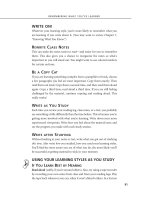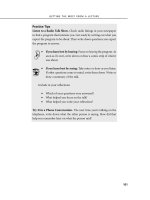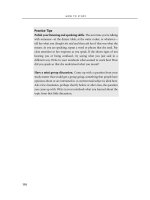Getting More Out of Reading
Bạn đang xem bản rút gọn của tài liệu. Xem và tải ngay bản đầy đủ của tài liệu tại đây (73.59 KB, 10 trang )
75
CHAPTER
10
G
ETTING
M
ORE
O
UT OF
R
EADING
You can make more sense
of what you’re reading
when you get involved
with it. And you can do
this by anticipating what
you read before you
begin. While you read, ask
questions, make pictures in
your head, take notes, and
use your learning styles.
Stop when you don’t know
something, wait until you
understand it, and then
continue with the reading.
After you’ve finished
reading, think about what
you’ve learned.
H
ere’s a hard but not surprising truth:
Reading is work. It can be easy and enjoyable work, like
reading a good story or the comics. Or, it can be more
challenging work, such as reading a textbook or other study material.
Now think a minute about work. If you show up at your job and
just sit there till quitting time, did you work? No, you put in your time,
but you didn’t work—and if you keep acting that way, you’ll get fired.
It’s the same way with reading. If you just sit there, moving your eyes
There’s Reading—and There’s Reading
“I just don’t get this marine biology book. I can’t understand the
first chapter. I read it, and I don’t get anything out of it,” Sally com-
plains to Harry.
“How are you reading it?” Harry asks.
“What do you mean—how?” she answers.
“Well, how involved are you with what you’re reading?”
“What do you mean—involved? Reading is like TV, you look at
it and you get meaning,” Sally says.
“It sounds like you need to read more actively,” Harry tells her.
“Reading is very different from watching TV.”
Sally has a problem. She expects reading to come to her, like
her favorite sitcom on TV. She’s not treating reading as work, but
rather as a relaxing pastime. Having a difficult reading assignment
make sense means asking questions, making connections, and cre-
ating order—getting involved!
HOW TO STUDY
76
over the page, you aren’t really reading—and you’re not getting anything
out of it. To get the most out of what you read, you have to get actively
involved in the material. Your mind should be working before, while, and
after you read.
BEFORE YOU READ
W
HAT
’
SINA
T
ITLE
?
You have a title, even if you didn’t win a world heavyweight boxing match.
Mr., Ms., Mrs., and Miss are titles. In a sense, so are Mom, Dad, Sis, and
Brother. And there are many more. Get out your notebook and list your
own titles. Start with your name, your family relationships, and what peo-
ple call you in a formal setting (like Mr. or Ms.). List your job titles, and
any positions you hold in volunteer or professional organizations.
Like people, chapters, lessons, and books have titles that tell you
what they’re about. Just as you know Ms. Smith isn’t a man, you know the
article “Cooking Peas” isn’t about carrots. Titles are there to eliminate
confusion and give a general impression before the finer details are
known. Titles can tell you a lot—don’t overlook them!
GETTING MORE OUT OF READING
77
Test the definition of title by applying it to the chapter you are read-
ing now. The chapter title is “Getting More Out of Reading.” Read the
summary that appears next to the title. It says the same thing as the chap-
ter title, but in more words. The chapter section you’re reading now is
called “What’s in a Title?” It’s part of a larger section called “Before You
Read.” As you make sense of what the author is saying about titles, you’re
answering the question of this section’s title, “What’s in a Title?”
G
ET
R
EADY TO
R
EAD
Start thinking about what you will be reading before you even begin to read.
First, choose a section to read. If the reading is divided into chapters, a chap-
ter is a good place to start. If it’s a long chapter with sub-headings, begin
with the first sub-heading. Look at the title of the chapter, the sub-heading,
or the article only. Write down your answers to these questions:
• What does the title make you think of?
• What do you expect the reading to be about?
• What questions do you expect the reading to answer?
If Sally, who we met in the beginning of this chapter, followed this
advice, her mind wouldn’t start to drift to other things, like what she’s
doing tonight, or how she’s going to get home. She would be actively
engaged in deciphering titles in her marine biology book. Making a study
plan and sticking to it would help Sally stop daydreaming.
U
SING
I
LLUSTRATIONS
If the reading has any illustrations, photographs, or drawings, look at
those, too. Write:
• What the illustrations seem to be about
• How the illustrations might connect with the title
When you study the title and illustrations before you read, you are
pre-reading. You are preparing to read by first getting in touch with what
you already know about the topic.
Try It!
HOW TO STUDY
78
U
SING
Y
OUR
O
WN
S
PECIAL
F
ILING
S
YSTEM
Your brain has a wonderful filing system. It files everything you have
seen, heard, tasted, and felt. All your experiences are up there—both your
actual experiences and what you learned through reading, seeing, and
listening. Information is stored in different compartments of your brain;
each compartment has a specialty.
When you pre-read, you are reminding yourself of information you
already know. You’re putting yourself right in front of the “file cabinet”
you need, ready to pull other information you already know—and ready
to add new information. When you pre-read, you are more likely to
remember what you’ve read. You’re also more likely to enjoy it because
you’ve begun to connect it with what you already know.
Sally, the marine biology student, remembers her summer trips to
the beach as a child. She remembers the different kinds of shells she
collected. Her mental file cabinet is ready for new files on marine
biology. She begins making sense of what she is reading—and to enjoy
and learn from the marine biology book.
AS YOU READ
Now that you’ve already gotten into the file cabinet in your head by
pre-reading, you want to be ready to add new folders or information to
your file cabinet. You need to be able to hold onto the new information
you’ll acquire as you begin to read the article or chapter.
K
EEPING A
R
EADING
L
OG
When you wrote down or recorded your pre-reading ideas and questions,
you began your reading log. This is a notebook (or audiotape) that helps
you keep track of what you’re reading, what it means to you, what
questions you have, and what answers you are discovering.
You add to it when you write and/or draw pictures to make sense of
new information. It’s a good idea to take notes on everything you read.
You might want to use thin notebooks that you can easily carry anywhere
you find yourself reading. Perhaps your instructor has test booklets you
could use for reading logs. These can be folded into a pocket or purse,
making it easy to read and take notes while you’re just about anywhere—
on the bus, on your lunch hour, in the waiting room.
GETTING MORE OUT OF READING
79
You might want to make a narrow column on each page of your
reading log to jot down the page numbers of the text you’re writing notes
about. This makes it easy for you to go back to check information. If
you’re expected to write a report on what you read, your log provides you
with a head start. In it, you’ve already written pages that refer to specific
information, quotes of what’s important or questionable, your feelings
on what you read, questions that you had, and what associations and
experiences came to mind.
You can also keep a reading log on audiotape, though this is a
little less convenient. However, if you’re strongly oriented to using your
ears rather than your eyes, you may find that speaking into a tape and
listening to it later is more useful than writing in a notebook. In that case,
make sure you have a small tape recorder you can carry with you any-
where.
This reading log is just for you. No one else will ever see or hear it
unless you choose to show it to someone. So you can write or say
whatever you want. Even if the associations you make seem a little silly to
you, even if your questions seem too stupid to ask in class—write them
down. Those silly associations may help you remember, and those stupid
questions can’t be answered until you ask them, even of yourself.
E
XPERIENCE
C
OUNTS
!
Every time you read something new, you’re adding to your experience. To
help you hold onto the new information, continue to connect it with
what you already know. If something is new to you and you have little
experience that relates to it, be prepared to stop. Stopping helps you
remember and gives your brain time to process what you’ve just learned.
After you’ve read the first couple of sentences of a reading, ask your-
self what it means and how it goes along with your pre-reading idea of
what it was going to be about. Look for the main idea of the reading,
which is usually found either in an introduction or first paragraph. (You
may wish to review Chapter 8, “Knowing When You Don’t Know.”)
For example, Sally, who is studying marine biology, should stop
and ask herself, “What was in that first paragraph that sticks out in my
mind? Is this what I expected from reading the title and subheadings of
this chapter?” If nothing stands out about the first paragraph or two, she
should go back and read them again.









